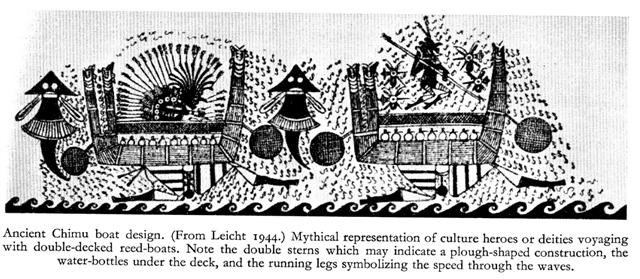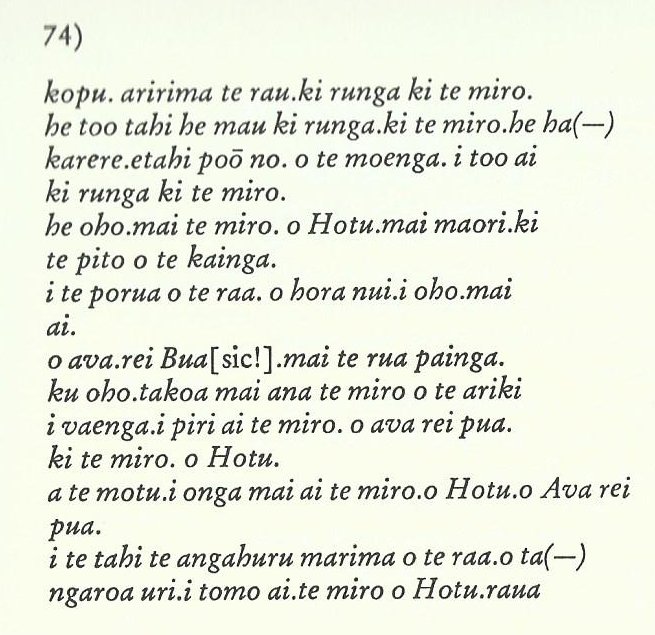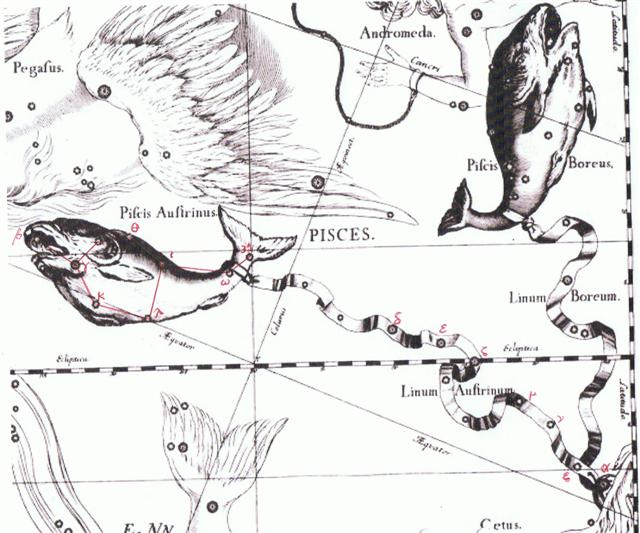When the explorers went back to their yam
plantation (where earlier Kuukuu had been ordered
to dig) it coincided with the time when their king
sailed away:
"For six days (po ono), mats (moenga)
were taken on board the canoe (i.e., the loading of the
canoe took six days). Hotu's canoe sailed from
Maori to Te Pito O Te Kainga. It sailed on
the second day of September (Hora Nui)."
(Manuscript E, p. 74.)
|
Ahu Akapu A Hau Maka |
Te Pito O Te Kainga A Hau
Maka |
Pu Pakakina A Ira |
|
6 days for loading the
canoe of Hotu Matu'a: |
 |
 |
 |
 |
 |
 |
|
Ga4-11 |
Ga4-12 |
Ga4-13 |
Ga4-14 |
Ga4-15 |
Ga4-16 (99) |
|
Shir (158.9) |
p Carinae (159.3) |
φ Hydrae (160.3) |
no star listed (161) |
Vathorz Posterior
(162.1),
Peregrini,
η Carinae (162.6) |
ν Hydrae (163.1) |
|
Hora Iti 26 |
27 |
28 (*160) |
29 |
30 (242) |
31 (*163) |
|
ºAugust 22 |
23 |
24 (236) |
25 (237) |
26 |
27 (*159) |
|
'July 30 (*131) |
31 |
'August 1 (213) |
2 (214) |
3 (*135) |
4 (216) |
|
"July 16 |
17 (*118) |
18 (199) |
19 (200) |
20 |
21 (*122) |
|
α/91 Lac. (341.1), Homan, β
Piscis Austrini (341.2), ν
Tucanae (341.5), υ Aquarii
(341.9) |
η Aquarii (342.1), Situla
(342.7) |
ε Piscis Austrini (343.5), ο
Pegasi (343.8) |
Matar (344.2) |
Leap night |
λ Pegasi (345.0), ξ Pegasi
(345.1), τ Aquarii (345.7),
μ Pegasi (345.9) |
|
Tehetu'upú
25 |
26 (422) |
27 (58 = 2 * 29) |
28 |
29 (60) |
Tarahao 1 (*345) |
|
426 - 366 = 60 |
|
ºFebr 21 |
22 (418) |
23 (54 = 2 * 27) |
24 |
25 (56) |
ºFebruary 27 (*341) |
|
422 - 365 = 57 |
|
'Jan 29 (*314) |
30 |
31 (396) |
'February 1 |
2 (33) |
3 (399) |
|
"Jan 15 (*300) |
16 |
17 |
18 (383) |
19 (384) |
20 |
|
¬
King out at Sea ® |
 |
 |
|
Ga4-20 |
Ga4-21 (104) |
|
11h (167.4) |
Al
Sharas
(168.6) |
|
χ¹ Hydrae (167.1), χ²
Hydrae (167.3) |
|
Hora Nui 4 (*167) |
5 (248) |
|
ºAugust 31 (*163) |
ºSeptember 1 (244) |
|
'August 8 (220) |
9 (*141) |
|
"July 25 (206) |
26 (*127) |
|
Al Fargh al Mukdim-24 /
Purva Bhādrapadā-26 /
House-13 |
23h (350.0) |
|
Scheat
Pegasi, π Piscis
Austrini (349.3),
MARKAB PEGASI
(349.5) |
π Cephei (350.6) |
|
Tarahao 5 (64) |
6 (*350) |
|
ºMarch 2 (61 = 64 - 3) |
3 (*346) |
|
'February 7 (403) |
8 (*323 = *350 - 27) |
|
"January 24 (389) |
25 (*309 = *350 - 41) |
Ga4-17 is glyph
number 100 and suitable as a day
zero. This Rei glyph
could possibly allude to the
fully loaded double-canoe. Ships
are female and the King was a
passenger - which maybe could
explain the peculiar text in p.
74 of Manuscript E:
"Hotu's
canoe sailed from Maori
to Te Pito O Te Kainga.
It sailed on the second day
of September (Hora Nui).
The canoe of the king (ariki
is used here incorrectly for
tapairu 'queen'), of
Ava Rei Pua, also
sailed on the other side.

They had
attached the canoe of
Ava Rei Pua to the
middle of the canoe of
Hotu (i.e., a
double canoe had been
built for the long
voyage across the sea)."

|
Ava
1. To remain (of
dregs, of very
small objects in
the water or in
a place which
used to be full
of water);
he-ava,
he-paroparoko,
expression,
said when small
fishes swarm in
the water holes
along the coast.
2. Furrow, rut,
groove, crevice,
fissure;
he-hahata te ava
o te henua,
a crevice opened
in the ground.
3. To strike, to
hit; to sound
like a blow;
ku-ava-á te poko
(see also
hatutiri),
thunder sounded.
Vanaga.
Áva-áva.
1. To lift up.
2. to strike, to
hit repeatedly;
he-áva-áva i
te koreha a ruga
a te ma'ea,
he struck the
eel several
times against a
stone (to kill
it). Vanaga.
1. a) Distance,
distant; ava
poto, a
short distance.
b) Space,
interval. PS
Mq.: ava,
distance, space,
interval. Ta.:
ava,
interval. The
simpler form of
the root is
va, which is
not found in
Rapanui and
Marquesan, and
in Tahiti is
narrowly
restricted to
the spacing of
thatch, but in
Nuclear
Polynesia and in
the Tongafiti
migration [va]
is expressive of
the sense of
distance and
interval. In
Samoa the same
meaning is
carried by an
advanced form of
the root, and
ava in this
sense is not
found elsewhere.
Its reappearance
in these three
languages of
Southeast
Polynesia points
to a direct
migration from
Samoa. 2.
Channel, strait,
pass, passage,
breach, entrance
to a harbor.
Avaava. 1.
a) To strike, to
slap, to grind,
to dent. b) To
correct, to
maltreat, to
exterminate. 2.
Angle, chink. 3.
Tobacco. In this
nook of
Polynesia
tobacco and its
common method of
pleasurable use
are alike
imported. In
Melanesia
tobacco was
indigenous but
was employed for
the business of
medication and
not to assuage
the conditions
of cannibal
society. The
leaves when
fully grown were
shredded,
macerated and
employed as a
cataplasm.
Applied upon the
abdomen it was
the principal
agency in the
production of
emesis and
catharsis.
Applied secretly
in axilla
[arm-pit] it
superinduced the
ecstasy of the
priest when in
the trance of
possession by
his god. In Fiji
it was used as
an insecticide.
Avahi, a
wedge, to split;
avahiga,
part, partial;
avahiga kore,
inseparable.
Avamouga (ava
1 - mouga
2), valley.
Churchill. |
1. Awa, s. Haw., harbour, cove, creek, channel; awaa, to dig as a pit, a ditch; awawa, a valley, space between two prominences, space between the fingers and toes. Tah., ava, a harbour, channel. Sam., ava, a boat-passage, opening in the reef, anchorage; v. to be open, as a doorway. Marqu., ava, interval, passage.
The Malgasse ava, a rainbow, may refer to this family, in the sense of an arch, a bay, a hollow, curved space on the firmanent.
Sanskr., avaţa, a pit; avata, a well; avatas, below, in the lower regions; ava-kâça, space, interval; avama, low, opp. to high, probably all referring themselves to ava, prep. with the primary sense of 'down, below, away, off', as its derivatives plainly indicate.
2. Awa, s. Haw., fine rain, mist. Tong., Sam., afa, storm, hurricane; afu, a waterfall. N. Zeal., awa, a river. Fiji., cava, a storm. Mal., awap, mist, dew. Sangvir Island, sawan, a river. Rotti, Ofa, id. Tagal., abo-abo, rain. Malg., sav, mist, fog.
Sanskr., ap, apas, water. Lat., aqua; Romain, ava, water, rain-water.
Goth., ahwa; O. H. Germ., ouwa, water. Germ., aue, au, brook. Swed., å, id. Irish, abh, water; abhan, river. Welsh, aw, fluid. Pers., âw, âb, water.
A. Pictet ... refers the Celtic and Persian forms to a Sanskrit root av, 'ire', whence avana, rapidity, avani, river; and he refers the Latin and Gothic forms to a Sanskrit root aç or ak, 'permeare, occupare', from which spring a number of derivatives expressive of 'le mouvement rapide, la force pénétrante' ...
In view of the Polynesian forms, Haw., Sam., Tagal., and their meanings, I prefer to follow Benfey and Bopp in referring the West Aryan as well as the Polynesian forms to the Sanskrit ap, whether that be the original form itself or a contracted modification of it.
It seems to me to have been in the very nature of language that men in the olden times should have commenced by giving distinct and instantaneous names to objects around them, and to natural phenomena, before they invested those objects with names derived by after-thought and reflection from this or that quality characteristic of those objects. Many, if not most, of such original names were doubtless lost in the course of ages, and supplanted by synonyms derived from and expressive of some quality or other in the objects named; but many still survive to baffle the analysis of philologists, and to assert their claims to priority over synonyms that must necessarily have been of later formation.
3. Awa, s. Haw., Sam., Tah., name of a plant of a bitter taste, but highly relished throughout Polynesia - 'Piper Methysticum' - from which an intoxicating drink is made; the name of the liquor itself. Tong., N. Zeal., Rarot., Marqu., kawa, id. Haw., awa-awa, bitter. Sam., a'awa, id. Tong., N. Zeal., kakawa , sweet.
Sanskr., av, to please, satisfy, desire (Benfey); ava, nourishment (Pictet). Pers., âwâ, nourishment; abâ, bread. Lat., aveo, crave after, long for; avena, oats. (Fornander)
|
|
... The
water of
the
kava,
however,
has a
different
symbolic
provenance.
The
classic
Cakaudrove
kava
chant,
performed
at the
Lau
installation
rites,
refers
to it as
sacred
rain
water
from the
heavens... This
male and
chiefly
water
(semen)
in the
womb of
a
kava
bowl
whose
feet are
called
'breasts'
(sucu),

(pictures
from
Lindqvist
showing
very old
Chinese
cooking
vessels)
and from
the
front of
which,
tied to
the
upper
part of
an
inverted
triangle,
a sacred
cord
stretches
out
toward
the
chief
...
The cord
is
decorated
with
small
white
cowries,
not only
a sign
of
chieftainship
but by
name,
buli
leka,
a
continuation
of the
metaphor
of birth
-
buli,
'to
form',
refers
in
Fijian
procreation
theory
to the
conceptual
acception
of the
male in
the body
of the
woman
... |
The 'Mouth
of the Fish'
(Fomalhaut,
α Piscis
Austrini)
rose with
the Sun when
the King
sailed away
from the old
land. Later
they
evidently
changed the
position
slightly
forward in
time to
coincide
with Fum al
Samakah
(Mouth of
the Fish, β
Pisces).

However,
Manuscript E
appears to
have kept to
the old
tradition.
|











